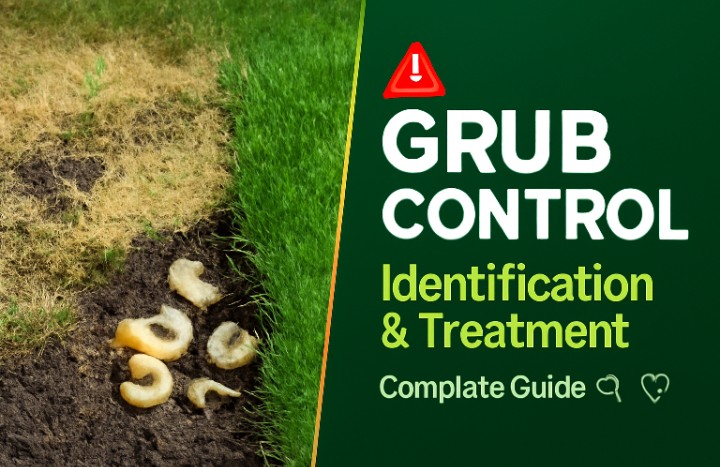Your lawn looked perfect last month. Now you are staring at brown patches everywhere. The grass peels back like old carpet. What happened? Grubs happened.
These white, C-shaped pests live underground. They munch on grass roots all day. Your beautiful lawn becomes their personal buffet.
Let me walk you through everything. You’ll learn to spot them early. You will discover treatment options that actually work. And you will save your lawn before it’s too late.
What Are White Grubs?
Grubs are baby beetles. Think of them as beetle larvae. They spend months underground eating your grass roots.
The most common types? Japanese beetles, June beetles, and masked chafers. European chafers also cause problems. Oriental beetles join the party too.
These critters look similar. White or grayish bodies, about half an inch long. They curl into a C-shape. Brown heads with six tiny legs. They are plump and wrinkly.
Their life cycle takes one year. Eggs hatch in summer. Larvae feed through fall. Winter sends them deep underground. Spring brings them back up. Then they become adult beetles.
Why Your Lawn Suffers
Grubs eat grass roots. Simple as that.
Healthy roots pull water from soil. They grab nutrients too. But grubs destroy this system. Your grass can’t drink. It can’t eat.
Brown patches appear first. Then the turf gets spongy. Walk across it and feel the difference. The grass lifts up easily. No roots hold it down anymore.
But wait, there’s more damage coming.
Raccoons love grubs. So do skunks and birds. They’ll dig up your lawn hunting for these tasty treats. Your yard becomes a disaster zone.
One homeowner in northeast Illinois learned this hard. His lawn looked fine in July. By August? Massive brown patches everywhere. He found 10 grubs per square foot. That’s way too many.
Spotting the Warning Signs
Don’t wait until it’s obvious. Early detection saves your lawn.
Visual Clues
Brown or yellow patches that ignore watering. They spread over time. The grass feels soft underfoot. Pull on the turf and it lifts like sod.
Damage shows up twice yearly. Late summer brings the first wave. Spring delivers round two.
Irregular shapes set grub damage apart. Not perfect circles like disease creates. Random, ragged edges instead.
Time to Investigate
Late August through early September works best. Grubs are small then. They are near the surface too.
Grab your shovel. Cut 12-inch square sections. Dig down 3 to 4 inches. Pull back the sod.
Count what you find. Check multiple spots. Grubs cluster in certain areas. One section doesn’t tell the whole story.
The Magic Number
Find 5 to 10 grubs per square foot? Time to treat.
But healthy lawns tolerate more. Some handle 20 grubs without problems. Stressed turf shows damage at lower levels.
This matters because treatment costs money. It affects the environment too. Don’t treat unless you need to.
A homeowner in Minnesota had this dilemma. She reseeded bare spots every spring. Professional treatments didn’t help. She watered during dry spells. That actually made things worse.
Identifying Different Grub Species
Not all grubs look identical. Knowing the difference helps.
Japanese beetle grubs are the most common. Adult beetles have metallic green heads. Their wing covers shine copper. Bodies measure about half an inch long.
Masked chafers come in northern and southern varieties. Adults are tan or light brown. They are smaller than Japanese beetles. Less flashy too.
European chafers create serious damage. Adults are light brown. They swarm around lights at dusk. Their grubs feed aggressively.
May and June beetles produce larger grubs. Adults are reddish-brown or black. They’re chunky and robust looking.
Oriental beetles prefer sandy soils. Adults have varied colors. Black, gray, or tan with patterns.
Green June beetles are different. Their grubs crawl on their backs. They move in a weird, distinctive pattern. Adults are metallic green with yellow sides.
Most homeowners don’t need to identify species. Treatment works the same for most types. But Japanese beetle grubs matter for milky spore users.
Wildlife Activity Tells a Story
Animals digging up your lawn? They’re probably hunting grubs.
But here’s the catch. Moles also eat earthworms. Skunks love all sorts of bugs. Animal damage doesn’t always mean grubs.
You need proof. Dig and count. Don’t guess.
The Grub Life Cycle
Understanding their schedule helps you fight back.
Summer Begins the Cycle
June and July bring adult beetles. They mate and lay eggs. Female beetles pick healthy, moist lawns. Your perfect turf attracts them.
Each female drops up to 50 eggs. The eggs sit just below the surface.
Fall Feeds the Problem
Eggs hatch in July. Baby grubs start eating immediately. August through October sees peak feeding. Root damage accelerates fast.
This timing explains why lawns fail in August. The damage actually started weeks earlier.
Winter Brings a Break
Cold temperatures drive grubs deeper. They burrow 6 to 12 inches down. Feeding stops completely.
They are still there though. Just waiting.
Spring Returns Them
April and May warm the soil. Grubs move back up. They feed briefly before changing form.
Late spring transforms them into adult beetles. The cycle starts over.
Preventing Grub Problems
Smart prevention beats emergency treatment every time.
Chemical Preventives Work Best
Several products stop grubs before they hatch.
Chlorantraniliprole (sold as Acelepryn or Scotts GrubEx) leads the pack. Apply between late April and early June. Earlier works better than later.
This chemical takes time to work. It needs 60 to 90 days to fully activate in soil. But then it lasts 4 months or more.
The big advantage? Safe for pollinators. Bees can land on treated flowers without harm.
University studies show 65 to 80 percent grub reduction. One lawn care pro from Kansas City swears by it. He’s used it for years with consistent results.
Imidacloprid (Merit brand) offers another option. Apply mid-June to early July. Closer to egg hatch works better.
This one reduces grubs by 75 to 100 percent. But there’s a downside. It’s a neonicotinoid. Bee-safe? Not really.
Clothianidin and Thiamethoxam work similarly to Imidacloprid. Same timing, same effectiveness, same pollinator concerns.
Application Makes or Breaks It
You must water these products in. Half an inch minimum. Immediately after spreading.
Why? The chemicals need to reach the root zone. Without water, they sit on top. Grubs below stay safe.
Mow before application. Remove flowering weeds. This protects any bees visiting your lawn.
A lawn forum user in Canada made this mistake. He applied product but didn’t water enough. His grub problem continued.
Natural Alternatives Exist
Some folks prefer organic methods. These work too.
Beneficial nematodes are microscopic worms. They hunt and kill grubs. Death comes in 24 to 48 hours.
Apply when soil temperatures hit 55 to 95 degrees Fahrenheit. Evening or overcast days work best. Sunlight kills nematodes fast.
Keep soil moist after application. Dry conditions kill your helpers. Apply 2 to 3 times per season for best results.
Milky spore targets Japanese beetle grubs only. Nothing else. One application lasts 15 to 20 years in warm climates.
But northern states face problems. New England homeowners report poor results. Cold soil temperatures prevent establishment. The bacteria needs 60 to 70 degrees to work.
It also takes time. Three to five years before full control. You need patience.
Bacillus thuringiensis galleriae offers newer technology. Grubs must eat it to die. Sunlight breaks it down quickly. Multiple applications often needed.
Build Strong Turf
Healthy lawns fight grubs better.
Deep, infrequent watering grows strong roots. Once a week works. Skip daily sprinkling.
Mow at proper height. Most grasses want 2.5 to 3.5 inches. Taller grass develops deeper roots.
Fertilize according to soil tests. Annual aeration improves root growth too.
Consider resistant grass varieties. Tall fescue handles grubs well. Zoysia and bermudagrass work in warmer areas.
Keep lawns dry during July. Beetles prefer moist soil for egg-laying. A temporary brown lawn beats grub damage.
Fighting Active Infestations
You missed the prevention window. Grubs are already feeding. Now what?
Curative Treatments Move Fast
Trichlorfon (Dylox brand) works quickest. Grubs die in 1 to 3 days.
Expect 70 percent or better control. It’s the gold standard for emergencies.
One warning though. Alkaline water breaks it down. If your water pH exceeds 7.2, effectiveness drops.
A lawn care professional from Massachusetts keeps Dylox in his truck. Active grub damage? He reaches for this first.
Carbaryl (Sevin brand) offers an alternative. But results vary. Some lawns respond great. Others see little improvement.
Big downside here. It kills beneficial insects. Honeybees especially. Ground beetles that eat grubs? Gone too.
Timing Matters Critically
Late summer and early fall work best. August through September hits grubs when they’re vulnerable.
Spring applications only help before mid-May. After that? Save your money. Grubs stop feeding to pupate.
Expect 20 to 80 percent kill in August. Wait until October? Results drop to 20 to 55 percent.
Full-size grubs resist treatment. Mid-September onward rarely gives more than 50 percent reduction.
Application Steps
Mow first. Then spread product evenly. Water immediately with half an inch.
The irrigation step is critical. Products must reach grubs underground. Surface applications fail completely.
Results take 10 to 14 days. Keep watering during this time. Fertilize after treatment.
One homeowner’s experience illustrates this. He found his fescue lawn devastated in late July. Yellow patches turned brown within a week. The grass pulled up in sheets.
He counted 10 grubs per square foot. Treatment with Dylox saved what remained. But he learned prevention beats cure.
Organic Curative Options
Beneficial nematodes work curatively too. Apply when grubs actively feed. Reapply every 2 to 3 weeks for severe problems.
Evening application protects nematodes from sunlight. Maintain soil moisture constantly.
Effectiveness drops compared to prevention. But it’s safer for the environment.
Application Best Practices
Good technique multiplies product effectiveness.
Spreader Settings Matter
Calibrate your spreader first. Follow label instructions exactly. Too much wastes money. Too little leaves grubs alive.
Apply on calm days. Wind blows product off target. It might hit flowering plants.
Safety First
Mow before any application. This removes flowering weeds. Pollinators stay safe.
For neonicotinoids, ensure zero flowers are present. Even dormant flowers contain residue.
Chlorantraniliprole is different. Safe even when directly sprayed on flowers.
Keep kids and pets away. Follow label timing. Usually 24 hours after treatment.
Post-Application Care
Water immediately unless label says otherwise. Half an inch minimum gets products into soil.
Monitor damage over the following weeks. Some treatments take time to work.
Continue regular lawn maintenance. Fertilizing and watering support recovery.
When to Actually Treat
Not every lawn needs treatment. Honest assessment saves money and protects the environment.
Treatment Makes Sense When
Last year brought grub damage. You saw lots of adult beetles in summer. Current damage shows high grub counts. Professional turf demands perfection.
Skip Treatment If
No previous grub problems exist. Counts stay below 5 per square foot. Your healthy lawn tolerates current populations. Occasional sod replacement costs less.
Many lawns go years without issues. Don’t treat based on fear or advertising.
Cost-Benefit Analysis
Annual treatments cost $50 to $200 per lawn. Repeated applications add up. Environmental impact increases too.
Compare this to occasional reseeding. Maybe $100 every few years. For many homeowners, that’s smarter.
Consider your lawn’s purpose. Show lawn? Treat preventively. Back yard? Tolerate some damage.
Common Mistakes Kill Results
Avoid these errors. They waste money and time.
Timing Failures
Applying preventives in August? Too late. The grubs already hatched.
Spring curative treatments after May 15? Useless. Grubs stopped eating.
Treating during winter? They are deep underground and dormant.
Not watering products in? They never reach grubs.
A homeowner applied chlorantraniliprole in July. He wondered why it failed. The product needs application before June for full effectiveness.
Wrong Product Choices
Pyrethroids alone don’t touch grubs. Lambda-cyhalothrin, bifenthrin, deltamethrin all fail. These kill surface insects only.
Using preventive products for active infestations wastes time. The damage continues while you wait.
Milky spore for non-Japanese beetle grubs accomplishes nothing. It’s species-specific.
Applying nematodes in direct sunlight kills them instantly.
Misdiagnosis Disasters
Drought stress looks like grub damage. Both create brown patches. Water first, then investigate.
Disease creates similar symptoms. So does dog urine. Confirm grubs before treating.
Animal activity does not always indicate grubs. Dig and count first.
A lawn care forum shared this story. One user treated for grubs repeatedly. Professional companies came twice. The problem continued.
Final diagnosis? Chinch bugs, not grubs. Wrong pest, wrong treatment, wasted money.
Year-Round Lawn Care Strategy
Preventing grub problems starts with overall health.
Spring Actions
Inspect for spring grub feeding. Count if damage appears. Apply preventive products between April and June.
Overseed thin areas. Fertilize based on soil tests.
Summer Management
Watch for adult beetles. They signal egg-laying time. Keep lawn slightly dry during July.
Continue proper mowing height. Water deeply but infrequently.
Fall Activities
Inspect soil in late August. Count grubs per square foot. Apply curative treatment if needed.
Aerate and overseed damaged areas. Prepare lawn for winter.
Winter Monitoring
Grubs are dormant but planning helps. Order products for spring. Adjust next year’s strategy.
The Integrated Approach
Best results come from multiple strategies. This system is called Integrated Pest Management.
Monitor Regularly
Check turf health weekly during growing season. Look for early damage signs. Don’t wait until disaster strikes.
Sample soil annually in late August. This timing catches grubs early. Record your findings in a notebook.
Track beetle populations each summer. Count adults around outdoor lights. High beetle numbers predict egg-laying.
Document damage patterns over years. Some lawn areas get hit repeatedly. Others never see problems. This knowledge guides treatment decisions.
A Pennsylvania homeowner kept records for five years. He discovered grubs only damaged his south-facing slope. The shady back yard stayed clean. Now he treats selectively.
Set Realistic Thresholds
Decide acceptable damage levels beforehand. What can you tolerate? Perfect turf or functional grass?
Use 5 to 10 grubs per square foot as general guidance. But adjust for your situation. High-traffic play areas need lower thresholds. Back corners can handle more.
Consider lawn use too. Kids playing sports? Keep thresholds lower. Decorative areas? You might accept more damage.
Don’t panic at first grub sighting. Healthy lawns coexist with some grubs. Treatment isn’t always necessary.
Combine Methods
Cultural practices reduce grub attraction. Healthy turf tolerates more feeding. Chemical or biological treatments handle serious problems.
Start with the least intensive approach. Try cultural methods first. Add treatments only when needed.
Spot-treat heavy infestations. Blanket applications waste money. They harm beneficial organisms unnecessarily. Treat problem areas only.
One Massachusetts lawn care company follows this model. They inspect carefully first. Treatments go only where counts exceed thresholds. Customer satisfaction increased while chemical use dropped.
Evaluate Results and Record Keeping
Assess treatment results the following season. Did grub populations decrease? Did damage improve?
Keep detailed records of everything. Application dates matter. Product names and rates too. Weather conditions during application help.
Note what worked and what failed. Patterns emerge over time. Your lawn becomes easier to manage.
Adjust strategy based on outcomes. Successful treatments get repeated. Failures get replaced with better options.
Create a simple spreadsheet. Column for dates, products used, grub counts, and damage levels. Review it each spring before planning.
This data-driven approach beats guessing. You will spend less while achieving better results.
Building Long-Term Resistance
Strong lawns need less treatment over time.
Choose Resistant Varieties
Tall fescue handles grub feeding better than bluegrass. Zoysia works in transition zones. Bermudagrass thrives in southern areas.
Overseed with these varieties gradually. Don’t expect instant transformation.
Improve Soil Health
Test soil pH and nutrients. Adjust as needed. Most grasses prefer slightly acidic conditions.
Add organic matter through compost topdressing. Improves drainage and root growth.
Aerate compacted areas annually. Reduces stress on grass.
Develop Deep Roots
Water encourages this. Deep, infrequent watering beats shallow, daily sprinkling. Roots follow moisture downward.
Proper fertilization strengthens root systems. Avoid excessive nitrogen. It creates weak, succulent growth.
Environmental Considerations
Protecting your lawn should not harm the environment.
Choose Least Toxic Options First
Try cultural methods before chemicals. Use targeted treatments instead of blanket applications. Select products with lower environmental impact.
Chlorantraniliprole protects pollinators. Beneficial nematodes harm only target pests. Consider these before harder chemicals.
Protect Water Sources
Never apply near streams or ponds. Follow buffer zone requirements. Avoid application before heavy rain.
Chemical runoff affects aquatic life. Responsible use protects ecosystems.
Support Beneficial Organisms
Your lawn hosts helpful insects. Ground beetles eat grubs. Earthworms improve soil. Spiders control other pests.
Broad-spectrum insecticides kill everything. Selective treatments preserve beneficials.
Additional Resources and Expert Help
You don’t have to figure everything out alone. Many resources exist for homeowners.
University Extension Services
Every state has university extension offices. These provide free or low-cost assistance. Staff know local grub species and timing.
Extension websites offer fact sheets. They’re written for homeowners, not scientists. Download guides specific to your region.
Master Gardener programs connect you with trained volunteers. They answer questions at farmers markets. Many offer phone consultations too.
Soil testing labs identify nutrient problems. Healthy soil grows resistant turf. Tests cost $10 to $30 typically.
County extension agents provide personalized advice. Bring samples of damaged turf. They’ll examine it for free. Grubs, disease, or something else? They will tell you.
The University of Minnesota Extension helped one frustrated homeowner. She’d treated for grubs three years running. Damage continued despite professional applications.
The extension agent found chinch bugs instead. Different pest, different treatment needed. Problem solved within one season.
Professional Lawn Care Companies
Licensed applicators handle treatments safely. They carry proper insurance. Equipment calibration ensures accurate applications.
Commercial-grade products often work better. Professionals buy concentrated formulations. Application rates can be adjusted precisely.
Scheduled programs maximize effectiveness. Spring prevention followed by fall inspection. Adjustments made as needed.
Get multiple quotes before choosing. Ask about their grub management philosophy. Do they automatically treat every lawn? Or do they inspect first?
Verify licenses with your state. Check online reviews carefully. Better Business Bureau ratings matter too.
A good company explains their recommendations. They show you grub counts. Treatment decisions make sense based on evidence.
Turfgrass Specialists and Entomologists
Persistent problems need expert diagnosis. Something’s wrong if standard treatments fail repeatedly.
Turfgrass specialists focus on grass health. They identify stress factors beyond pests. Soil compaction, pH issues, disease problems.
Entomologists specialize in insects. They identify unusual grub species. Some require different treatment approaches.
Universities often provide diagnostic clinics. Mail in samples with detailed descriptions. Reports come back within weeks. Fees run $25 to $50 usually.
One New Jersey homeowner struggled for years. Beautiful lawn in May, destroyed by August. Multiple companies treated unsuccessfully.
A Rutgers University entomologist identified Asiatic garden beetles. Less common than Japanese beetles. Different biology required adjusted timing. Problem finally solved.
Online Resources Worth Checking
State extension websites offer the best information. Look for your state university’s extension page. Navigate to lawn care or pest management.
The National Pesticide Information Center answers questions. They are unbiased and science-based. Call or email with concerns.
Local gardening forums connect you with neighbors. They know what works in your area. Real experiences beat generic advice.
Avoid purely commercial websites. They push products whether you need them or not. Extension sources remain more trustworthy.
When to Call for Help
DIY works for many homeowners. But some situations need professionals.
Extensive damage across large lawns overwhelms most people. Commercial equipment covers ground faster.
Repeated treatment failures indicate misdiagnosis. Expert identification prevents wasted effort and money.
Health concerns about chemical exposure warrant professionals. They wear protective equipment. Application equipment reduces drift.
Physical limitations make spreading difficult. No shame in hiring help. Your back will thank you.
Very high-value landscapes justify expert care. Professionally installed lawns cost thousands. Protect that investment properly.
Product Information and Labels
Always read product labels completely. They are legal documents with critical information. Application rates, timing, and safety precautions appear there.
Check current product registrations. Some chemicals get banned or restricted. Your state might prohibit certain ingredients.
Verify rates for your local conditions. Southern states differ from northern regions. Soil types affect application amounts too.
Labels explain personal protective equipment needs. Gloves, masks, eye protection specified there. Follow these recommendations strictly.
Storage and disposal instructions matter. Keep products in original containers. Never dump extras down drains. Many communities hold hazardous waste collection days.
Mix only what you will use immediately. Leftover spray deteriorates quickly. Effectiveness drops in stored mixtures.
The END
Grub control isn’t mysterious. It requires knowledge, timing, and patience.
Identify the problem correctly first. Count grubs before treating. Choose products matching your timing.
Preventive treatments outperform curative applications. Apply them during correct windows. Water everything in properly.
Not every lawn needs treatment. Healthy turf tolerates some grubs. Assess your situation honestly.
Multiple approaches work together best. Strong cultural practices reduce problems. Targeted treatments handle serious cases. Environmental responsibility guides choices.
Your lawn can recover from grub damage. Sometimes it just needs time and proper care.
Start by inspecting your lawn this late August. Count grubs in problem areas. Decide whether treatment makes sense.
Then take action. Your grass will thank you next spring. Bye Bye 🥰






